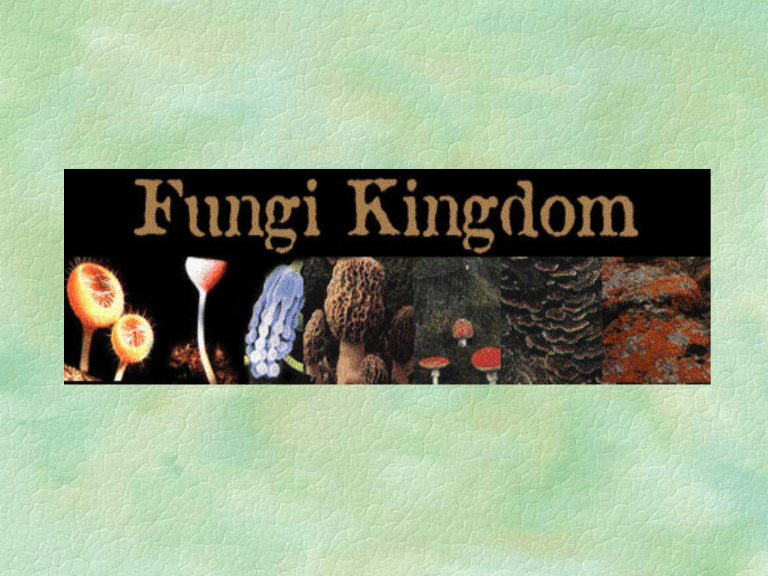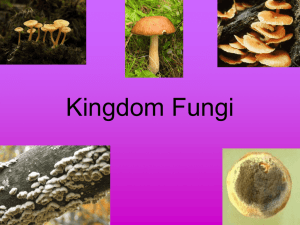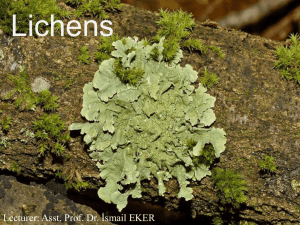The Fungi

Kingdom Fungi-Introduction
This is a very diverse group of organisms that includes yeasts, molds, rusts, and smuts.
Fungi lack chlorophyll and do not carry on photosynthesis.
Most are saprobes , although some are parasitic .
Kingdom Fungi-Intro.continued
Saprobes (shown here), release digestive enzymes that break down food.
Nutrients are then absorbed into the fungal cells.
Parasitic fungi obtain their nutrients directly from their hosts.
General Fungi Characteristics
Consist of threadlike filaments called hyphae .
Hyphae grow in a tangled mass to form the mycelium .
The hyphae are made up of cells containing the cytoplasm.
General Characteristics continued
Fungal cells may or may not have cross walls (partitions).
Cells with cross walls are called septate .
Fungal cells may be multinucleate.
Cell walls are made up of chitin
(a polysaccharide)
Reproduction is both asexual and sexual by means of spores.
80 000 species exist.
The Five Groups of Fungi
The fungi are divided into 5 groups based on their mode of reproduction:
Group 1: Phylum Zygomycota.
Known as the zygomycetes .
Both sexual and asexual reproduction exist.
Hyphae lack crosswalls. But crosswalls do form during gamete production.
Most are saprobes and some are parasitic.
Bread Mold Rhizopus sp.
Bread Mold Gone Bad !
Phylum Zygomycota
Sexual Reproduction in Rhizopus
Group 2 Phylum Oomycota
Phylum Oomycota
The Water molds
Most are saprobes and some are parasites on fish.
Some are plant parasites such as the late blight fungus that caused the Irish Potato Famine
(1845-1847).
Only group with motile flagellated spores.
Only group with structurally different male and female gametes (sperm and eggs).
Phylum Oomycota continued
Cell walls made of cellulose and not chitin.
Hyphae have no cross walls.
Diploid stage is dominant in their life cycle.
Group 3 Phylum Ascomycota
Largest known group.
Multicellular
Hyphae have cross walls.
Sac fungi form two types of spores:
Sexual Spore -produces in a sac-like structure called the ascus . 8 ascospores per ascus.
Asexual Spore -Produced at the tip of specialized hyphae called conidiophores.
The spores are called conidia .
Ergotism-An Ascomycete
Disease.
Disease caused by the plant parasite,
Claviceps purpurea .
Grows on rye.
Bread made with contaminated rye, causes severe illness in humans.
Ergotism continued
Symptoms include gangrene, nervous spasms and convulsions.
Ergot is used in medicine to cause blood vessels to constrict.
It is the initial source of the psychedelic drug
LSD.
Group 4 Phylum-Basidiomycota
Phylum Basidiomycota
The club fungi.
Spores form in a club-shaped structure called the basidium .
The spores are called basidiospores .
Hyphae are divided by incomplete crosswalls.
Cells have two nuclei.
Group 5 Imperfect Fungi
These molds do not fit into the other groups of fungi, as they lack sexual stages in their life cycles and hence are said to be imperfect.
Reproduction is asexual by way of spores.
Some are predatory and trap protists and small round worms.
Predatory Fungus
A Captured Nematode
Mycorrhizae
Many fungi form symbiotic associations with the roots of green plants, by way of mycorrhizae (“fungusroots”).
Some of these fungi form distinct layers on the outside of roots (ecto-mycorrhizae), while others are deep in the roots.
Mycorrhizae
The fungi get sugars from the plant host.
The plant itself gets nutrients from the fungi, including nitrogen and phosphorous.
The mycorrhizae also protect plants from heavy metals by acting as filters.
The Lichens
Lichens are formed when certain algae join with certain fungi .
Mr. Algae
Mr. Fungus
Lichens-A Symbiotic
Relationship
Together, the algae and the fungus form a living unit.
What we have here is a symbiosis.
The algae through photosynthesis produce sugar as a food source, and the fungus provides support and protection from drying.
General Structure of a Lichen
Foliose lichen – resembles lettuce.
Crustose Lichen – Fairy barf
Fruticose lichen-Old Man’s Beard
Microscopic View of a Lichen




